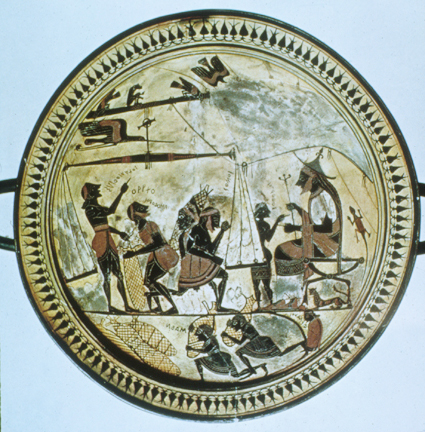
Market scene, Kylix from Sparta
Greek, 565-560 BCE
ART 198 - HISTORY OF WORLD CERAMICS
| Black Figure Ware was made in other parts of Greece, such as neighboring Sparta, and here the style was slightly different. Note here the use of a white ground, typical of Spartan (also called Laconian) ware. This kylix, or drinking cup, is seen from the top, with the side handles visible at right and left. Note the increasing skill of the painter in black figure ware to tell a story, to show movement, and to portray the human form. Here, slaves hurry with bundles to be weighed as the master sits on his elaborate chair, richly attired, overseeing the workers. The scale is clearly visible, oddly supported by a flying bird. The supervisor's intermediaries cry out the weights as the various goods are tallied. Their comments can be clearly seen coming from their mouths. All are shown with the characteristic 'frontal' eye, which stares directly at the viewer, even though all figures' faces are shown in profile. The social rank of the various individuals can be deduced from their relative sizes. Note that the master is the largest figure and most richly dressed. Next, the figures who call out the weights are somewhat smaller, and their attire is simpler. Smallest of all are the laboring slaves, who scurry at the bottom of the scene.Under the chair of the master sits his pet cat, and various other animals, such as a lizard, other birds, and even a monkey inhabit various spots of this rather eccentric scene. | Market scene, Kylix from Sparta Greek, 565-560 BCE |
|
|